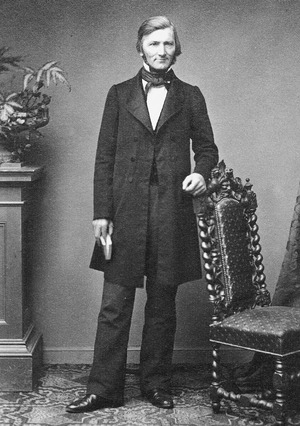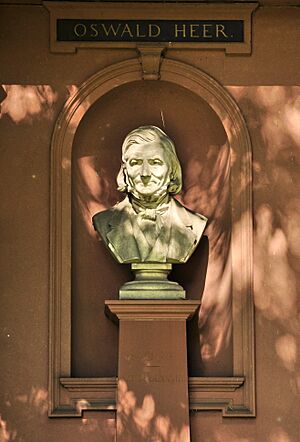Oswald Heer facts for kids
Quick facts for kids
Oswald Heer
|
|
|---|---|
 |
|
| Born | 31 August 1809 Niederuzwil, Switzerland
|
| Died | 27 September 1883 (aged 74) Lausanne
|
| Awards | Wollaston Medal (1874) Royal Medal (1877) |
Oswald Heer (born August 31, 1809 – died September 27, 1883) was a famous Swiss scientist. He was a geologist, which means he studied rocks and the Earth's history. He was also a naturalist, someone who studies nature. Heer was born in Niederuzwil, Switzerland, and passed away in Lausanne.
Contents
Life and Early Studies
Oswald Heer first studied to become a clergyman at the University of Halle-Wittenberg. He also earned degrees in philosophy and medicine. Early in his life, he became very interested in entomology, which is the study of insects. He learned a lot about them.
Later, he began to study plants. He became one of the first experts in paleobotany. This is the study of ancient plants found as fossils. He was especially known for his work on plants from the Miocene period.
In 1837, a Swiss botanist named Carl Daniel Friedrich Meissner honored Heer. He named a group of flowering plants from South Africa Heeria after him. These plants belong to the cashew family.
Professor and Plant Discoveries
In 1851, Heer became a professor of botany at the university of Zürich. For some time, he also led the Old Botanical Garden in that city. He focused his research on ancient plants and insects found in Switzerland. These came from the Tertiary period.
In 1863, he worked with William Pengelly to study plant remains. These were found in lignite deposits in Bovey Tracey, England. At first, they thought these plants were from the Miocene age. However, scientists now believe they are from the older Eocene period.
Heer also wrote about ancient plants from the Arctic regions. These were fossil plants brought back from Northwest Greenland. He also studied plants from the Pleistocene lignites of Dürnten. He even wrote about the grains found in ancient lake-dwellings.
In 1862, Oswald Heer was chosen to be a member of the American Philosophical Society. This is a very old and respected group of thinkers.
Heer and Charles Darwin
Charles Darwin, the famous scientist, thought Heer was an expert on fossil plants. They wrote letters to each other often. They had different ideas about evolution, but they were still friendly.
In 1875, Heer wrote to Darwin about a new fossil plant he found. This plant was from the lower Cretaceous period in the Arctic. This discovery suggested that flowering plants might have evolved earlier than Darwin had thought.
Heer also wrote his own ideas about evolution. In his 1867 book, The Primaeval World of Switzerland, he suggested that new species appeared more quickly. He believed in "progressive creation." This means he thought there were times when new types of living things were created. He also believed that the very first species needed an act of creation.
Later Life and Legacy
For much of his life, Heer faced challenges. He did not have a lot of money and often had poor health. However, his important work in science was recognized. In 1874, the Geological Society of London gave him the Wollaston Medal. This is a very high honor in geology.
Oswald Heer passed away in Lausanne on September 27, 1883.
Many places are named after him. These include Heerodden cape in Nordenskiöld Land on Spitsbergen. Also, the mountain Oswaldfjellet on Bear Island is named in his honor.
Key Publications
Oswald Heer wrote many important books and papers. Here are some of his well-known works:
- 1840 - Analytische Tabellen zu Bestimmung der phanerogamischen Pflanzengattungen der Schweiz
- 1840 - Flora der Schweiz; (with Johannes Jacob Hegetschweiler)
- 1846 - Der Kanton Glarus
- 1849 - "Die Insektenfauna der Tertiärgebilde von Oeningen und von Radoboj in Croatien"
- 1855-1859 - Flora tertiaria Helvetiae
- 1862 - Beiträge zur Insektenfauna Oeningens
- 1862 - Beiträge zur Fossilen Flora von Sumatra
- 1863 - On the lignite formation of Bovey Tracey, Devonshire; (with William Pengelly)
- 1865 - Die Urwelt der Schweiz
- 1865 - Die Pflanzen der Pfahlbauten
- 1867 - Fossile Hymenopteren aus Oeningen und Radoboy
- 1868-1882 - „Flora fossilis arctica - Die fossile Flora der Polarländer“
- 1869 - Miocene baltische Flora
- 1870 - Die Miocene Flora und Fauna Spitzbergens
- 1871 - Fossile Flora der Bären Insel
- 1872 - Le monde primitif de la Suisse
- 1874 - Die Kreide-Flora der Arctischen Zone
- 1876 - The Primaeval World of Switzerland (Edited by James Heywood)
- 1877 - Flora fossilis Helvetiae: die vorweltliche Flora der Schweiz
- 1878 - Beiträge zur fossilen Flora Sibiriens und des Amurlandes
- 1884 - Analytische Tabellen zur Bestimmung der phanerogamischen Pflanzengattungen der Schweiz


